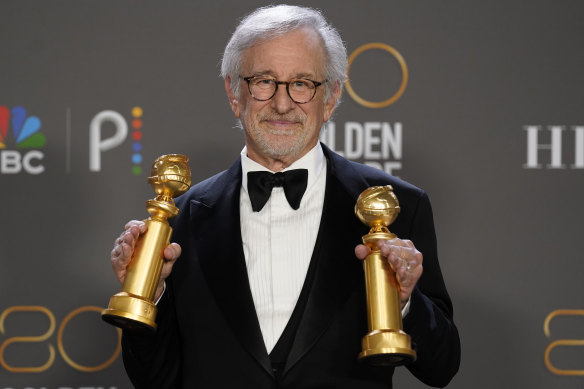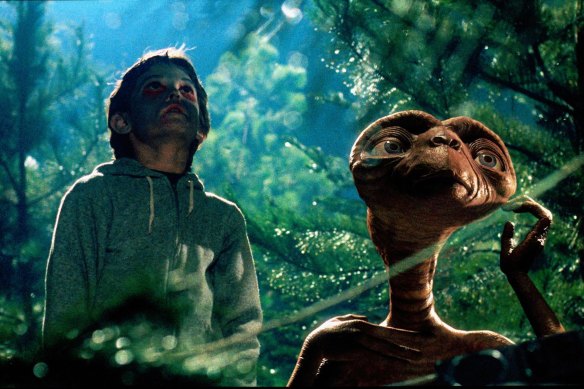By Tom Ryan
Steven Spielberg: The Iconic Filmmaker and His Work
Ian Nathan
White Lion Publishing, $59.99
Ian Nathan has been churning out stuff like this for the best part of a decade. Along with books about the Mad Max films, Peter Jackson’s Middle-earth saga and the screen adaptations of Stephen King’s writings and JK Rowling’s Fantastic Beasts and Where to Find Them, he’s now written a dozen about a veritable who’s who of recent Hollywood filmmaking: Tim Burton, Wes Anderson, Quentin Tarantino, Christopher Nolan, Ridley Scott, Guillermo Del Toro, James Cameron, David Lynch, the Coppolas, the Coen brothers and Clint Eastwood.

More than half of the books share the subtitle used for Steven Spielberg: The Iconic Filmmaker and His Work. There’s a plethora of iconic filmmakers around at the moment, and others doubtless itching to earn the accolade. Nathan and his publishers lie in wait, ready to wave the flag on their behalf.
But they will all have to line up on the podium behind Spielberg, who is, according to Nathan, “the most famous director who has ever lived”, “the most iconic director of them all”, and “the world’s pre-eminent entertainer”. A director whose best work, he proposes – referring to E.T. (1982), Schindler’s List (1993), Jaws (1975) and Lincoln (2012); his order of preference – has “a greatness that is often obscured by popularity”. An artist who tells mythological stories enriched by his “human touch”, and whose protagonists “are marked by their vulnerability, their mistakes, their yearning”.
How does he do it, Nathan asks up front. “Where does it come from – the Spielberg touch?” Then, by way of an answer, and selectively drawing on a range of previous books about Spielberg – by Joseph McBride, Molly Haskell, and others – as well as on others’ interviews with the director, he offers a chronological account of Spielberg’s career and a sketchy critical estimation of his films. Which finally amounts to no answer at all.

Spielberg at last year’s Golden Globe Awards.Credit: Invision
That’s not to say that Nathan’s commentary is without merit. When he’s writing about films that he really admires, he can be astute, and the chapter on E.T. – which, he asserts (with good reason), “belongs to the pantheon of great children’s stories” – is the best in the book. In passing, he also offers some telling insights: seeing Duel (1971) as “Jaws on wheels”; finding an unexpected connection between E.T. and Spanish filmmaker Victor Erice’s The Spirit of the Beehive (1973); and judiciously observing that the state of the nation “looms over the second half of his career, most notably in Amistad [1997], Lincoln and The Post [2017]”.
The weakest chapters are the ones in which he deals with films he has little time for, or is only lukewarm about. He’s (surprisingly) dismissive of Jurassic Park (1993) and has nothing positive (or interesting) to say about its 1997 sequel. Or about Always (1989), Hook (1991), or any of the Indiana Jones films after the first, Raiders of the Lost Ark (1989). And by the time he gets to Minority Report (2002), he seems to be rushing through the films simply for the book to appear complete.
Much of Nathan’s analytical energy is expended on finding Spielberg in his films’ protagonists. He sees a number of the director’s characters as “self-portraits”: Elliott in E.T., the characters played by Richard Dreyfuss in Jaws and Close Encounters of the Third Kind (1977), Indiana Jones and numerous others. He even ponders the alter-ego implications of Leonardo DiCaprio’s “great imposter” character in Catch Me If You Can (2002): “After all his success, could it be that Spielberg still felt like an imposter?”
There is a tantalising case to be made for this particular brand of auteurism: that directors might often see something of themselves in their films’ characters. And it’s quite possible that Spielberg, even before he came to make the fictionalised autobiography of The Fabelmans in 2022, had been, consciously or unconsciously, doing just that, “turning (mythologising?) his own life into Spielberg movies”. After all, as Nathan points out, the filmmaker himself has said, “Storytelling is my therapy”.

E.T., Nathan says, “belongs to the pantheon of great children’s stories”.Credit: Universal
However, I’m none the wiser about what he thinks “the Spielberg touch” is, how it came about, or even how it might be manifested in his films. I suspect that Nathan felt he had to be seen to be introducing a new slant into his study of a much-discussed – iconic! – filmmaker. And since the notion of “the Lubitsch touch” has long preoccupied film critics scrutinising the work of the famed – perhaps also iconic? – expatriate German filmmaker, Ernst Lubitsch, who immigrated to Hollywood in 1922, why not apply it to Spielberg?
Never short on hyperbole, Nathan’s book is content to skim across the surface of its subject, its often-purple prose serving the needs of a publisher committed to cranking out slick, handsome, coffee-table books. Which this is.
And for anyone looking for a snapshot overview of Spielberg’s work, it might serve as a useful starting point: it’s well-written, eminently presentable, readily accessible. But anyone seeking something more substantial should look elsewhere.
The Booklist is a weekly newsletter for book lovers from Jason Steger. Get it delivered every Friday.